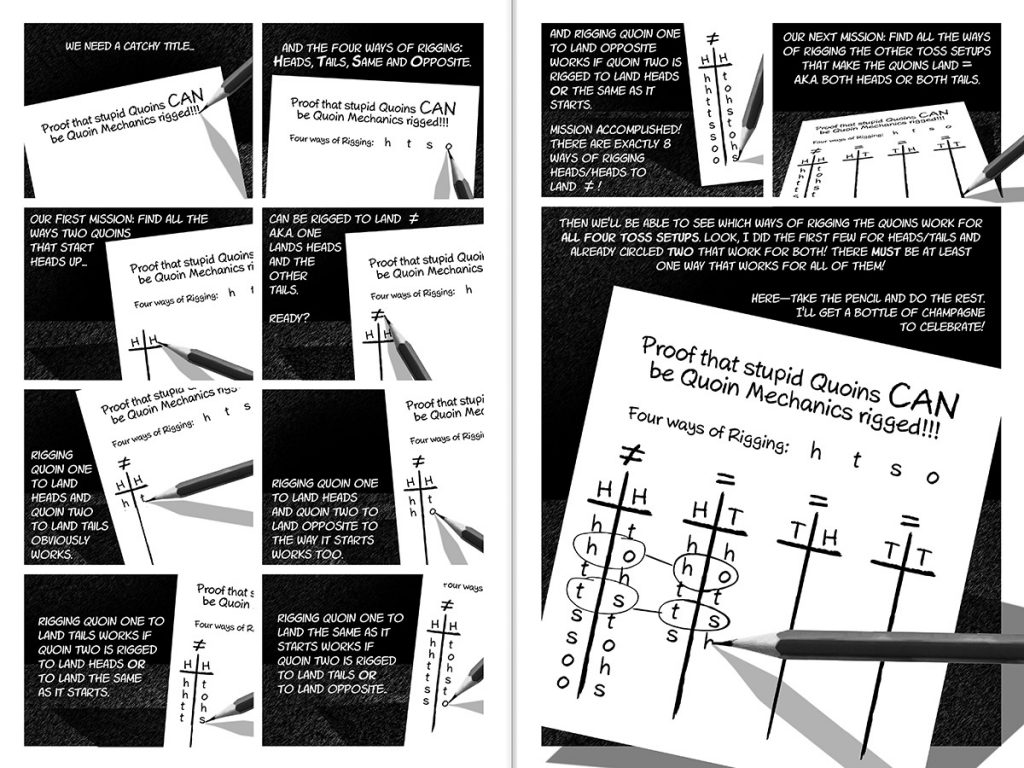It's All About Bell's Theorem
Totally Random is really all about Bell's proof. The book opens by handing you a pair of quoins—quarters that exhibit a curious correlation in the way they land when tossed. Using commonsense reasoning, you get to derive Bell's famous proof intuitively (with no math) so that you really understand it for yourself.
In a Nutshell...
Bell's theorem proves that it is impossible to rig two separated objects to curiously correlate their properties more than 75% of the time—unless they can communicate with each other. But particles (and quoins) exceed this limit.
So particles (and quoins) must sync by signaling to one another,right?
More on Bell & Bell's Theorem
Articles:
- J.S. Bell: On the Einstein-Podolsky-Rosen paradox
- J.S. Bell: Bertlmann's socks and the nature of reality
- J.F. Clauser et al: Proposed experiment to test local hidden-variable theories
Books:
- J.S. Bell: Speakable and Unspeakable in Quantum Mechanics
- Nicolas Gisin: Quantum Chance: Nonlocality, Teleportation and Other Quantum Marvels
Multimedia
Watch John Bell's talk on indeterminism and non-locality:
Henry Reich's Minute Physics video on Bell's theorem:

A Bit of History...
In May, 1935, Albert Einstein, Boris Podolsky, and Nathan Rosen published an article in the Physical Review with the title “Can quantum-mechanical description of physical reality be considered complete?” They argued that the only way to make sense of quantum mechanics is to suppose that the state descriptions of the theory are incomplete: something has been left out of the story. The article created quite a stir at the time, with pre-publication headlines in the Science section of The New York Times of May 4, 1935, based on an interview with Boris Podolsky, announcing: “Einstein Attacks Quantum Theory. Scientist and Two Colleagues Find It Is Not ‘Complete’ Even Though ‘Correct’.”

David Bohm took up the challenge and in 1952 published a modified version of quantum mechanics in which he added "hidden variables" to "complete" the theory. Bohm's theory produces the same predictions as quantum mechanics, given certain assumptions about the hidden variables.
In correspondence with Max Born (May 12, 1952), Einstein dismissed Bohm's theory as "too cheap for me." What Einstein objected to in Bohm's theory was probably its nonlocality, roughly that what happens over here instantaneously affects what happens over there (which conflicts with special relativity, even though the conflict would be unobservable given Bohm's assumptions). The behavior of a Bohmian particle - where it's trajectory will go at a particular time - depends on where all the other Bohmian particles are located. So a change in the position of a particle is instantaneously transmitted nonlocally to remote particles via the quantum wave function, which acts like a field guiding the particles in Bohm's theory.

In 1966, John Bell published a critical review of several results that claimed to prove the impossibility of reconstructing quantum mechanics as a hidden variable theory. He concluded the article with a discussion of Bohm's theory, in which he pointed out that the theory evades these results because the equations of motion are nonlocal, so that "an explicit causal mechanism exists whereby the disposition of one piece of apparatus affects the results obtained with a distant piece." He added that "the Einstein-Podolsky-Rosen paradox is resolved in the way in which Einstein would have liked least," and asked whether one could prove "that any hidden variable account of quantum mechanics must have this extraordinary character."
Bell answered this question in a separate paper by showing that adding hidden variables to quantum mechanics to complete the story is a non-starter if the hidden variables are required to be "local," in the sense that they provide a common cause explanation for quantum correlations when a direct causal connection isn't possible. He showed that any such theory would have to satisfy a certain inequality, which is violated by the correlations of entangled quantum states for certain combinations of measurements that Einstein, Podolsky, and Rosen didn't consider. He concluded:
In a theory in which parameters are added to quantum mechanics to determine the results of individual measurements, without changing the statistical predictions, there must be a mechanism whereby the setting of one device can influence the reading of another instrument, however remote. Moreover, the signal involved must propagate instantaneously, so that such a theory could not be Lorentz invariant [so consistent with special relativity].
Bell's theorem, as it is now called, appeared in 1964 - two years before the long-delayed publication of the article in which Bell posed the question about Bohm's theory.

